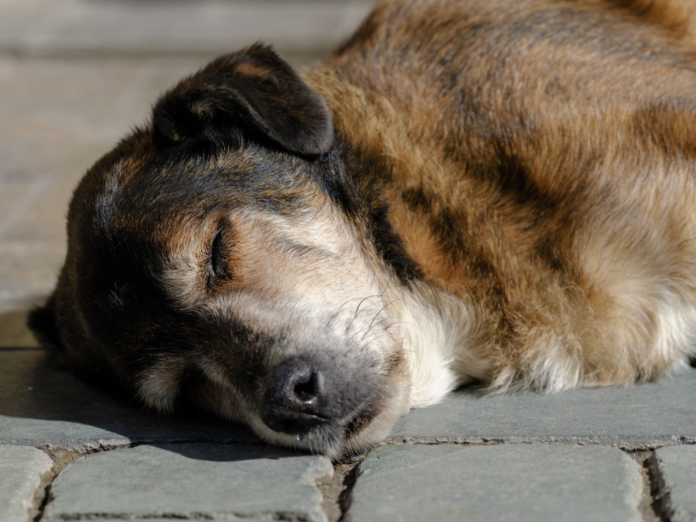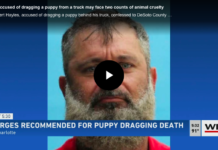Last Updated on November 6, 2023 by Fumipets
Heatstroke in Dogs: Understanding the Symptoms and Treatment
Heatstroke is a critical concern for dogs, especially during hot weather. This condition occurs when a dog’s body temperature rises to dangerous levels, often due to excessive heat exposure and an inability to cool down.
Recognizing the signs of heatstroke and taking swift action is crucial for your dog’s well-being. This guide provides essential information on heatstroke in dogs, including prevention measures, symptoms to watch for, and immediate steps to take if your dog shows signs of overheating.
Heatstroke in Dogs
Heatstroke, or hyperthermia, is a dangerous condition that can occur in both humans and animals. Dogs are particularly susceptible to heatstroke since they mainly rely on panting to regulate their body temperature.
It’s important for pet owners to be aware of the symptoms of heatstroke in dogs so they can take immediate action if their pet shows signs of distress.
Being prepared and vigilant can help prevent the dangerous negative health consequences caused by heatstroke. Having a dog or puppy routine for hydration could lower the risks for your pet.
What Causes Heatstroke?
Heatstroke is caused by overexposure to high temperatures or intense exercise in hot weather without adequate hydration.
Panting is the primary way dogs cool down; when a dog pants, he or she is able to take in cooler air which evaporates moisture off the tongue and inner lining of the lungs, reducing overall body temperature.
The evaporation process requires energy as well as water, so it’s important for a dog to stay hydrated when panting heavily. Dogs also have sweat glands located in their feet that help cool them down but are not as effective as panting.
Dogs with heavy fur coats, those who are overweight, senior dogs and puppies may be more prone to developing heatstroke as they have difficulty cooling themselves down through panting unlike smaller dogs like cavoodles are not too susceptible to heat stroke but come with different sets of health problems.
Furthermore, dogs that are left in cars on warm days are at a much higher risk for heatstroke since they cannot escape from the hot environment of a car.
Signs and Symptoms of Heatstroke in Dogs
The signs and symptoms of heatstroke can vary from mild discomfort to severe illness depending on how long the dog has been exposed to high temperatures or intense exercise. The most common symptoms include:
• Excessive panting
• Drooling
• Increased heart rate
• Anxiousness or restlessness
• Reddened gums and tongue
• Weakness or lethargy
• Vomiting
• Diarrhoea
• Collapsing or seizures
If your dog is showing any of these symptoms it’s important that you take action immediately as heatstroke can quickly become life-threatening if not addressed quickly.
Treatment for Heatstroke In Dogs
If you notice any signs of heatstroke seek veterinary care immediately as heatstroke can be life-threatening if not treated promptly. There are several ways you can try to reduce your dog’s body temperature while waiting for veterinary care:
- Move your pet into a cooler environment such as an air-conditioned room or shaded area outdoors
- Place cool (not cold!) wet towels on their head and chest
- Offer small amounts of cool water for drinking
- Monitor their body temperature regularly with a thermometer
- Do not use ice packs directly on the skin; this can cause further damage due to rapid cooling rates
You should also monitor their breathing rate and heart rate closely until you reach a vet clinic as these can increase significantly with prolonged exposure to high temperatures or vigorous activity.
It’s also important that you keep track of how long your dog has been exposed to excessive temperature as this will help your vet determine the best course of treatment.
Your vet may administer intravenous fluids, oxygen therapy, anti-nausea medications, electrolytes, and other supportive treatments depending on the severity of your pet’s condition.
They may also recommend that your pet stay overnight at the clinic for careful monitoring while they receive treatments such as IV fluids or oxygen therapy.
In some cases surgery may be necessary if there is organ damage present due to prolonged exposure to extreme temperatures without sufficient water breaks.
Prevention Is Key – How To Avoid Heatstroke In Your Dog
Fortunately, there are several steps you can take that will help reduce the chances of your dog suffering from heatstroke:
- Ensure that your dog has plenty of fresh drinking water throughout the day – keeping multiple bowls filled up around the house is a good tactic during the summer months.
- Make sure your dog has shaded areas available to retreat to during hot days – either indoors, with access through a doggy door, or outdoors where they won’t get too hot.
- Avoid exercising them during peak hours (10am – 4pm) when temperatures tend to be highest. Instead, try walking them in the early morning or evenings when temperatures are cooler.
- Don’t leave them unattended in cars during hot days – even with open windows temperatures can rapidly rise inside a parked car.
- Provide extra cooling support such as electric fans or misters during especially hot days.
By following these simple steps you’ll greatly reduce the chances of your pup suffering from potentially life-threatening heatstroke this summer season. Stay vigilant, and enjoy your summer with your dog safely.
FAQs About Heatstroke in Dogs
What are the common signs of heatstroke in dogs?
Signs of heatstroke in dogs can include excessive panting, drooling, rapid heartbeat, vomiting, diarrhea, weakness, and even collapse. It’s essential to act quickly if you notice these symptoms.
How can I prevent heatstroke in my dog?
Preventing heatstroke involves keeping your dog cool during hot weather. Provide access to shade, fresh water, and avoid strenuous exercise during peak heat. Never leave your dog in a parked car on a hot day.
What should I do if I suspect my dog has heatstroke?
If you suspect heatstroke, move your dog to a cooler area, offer water to drink, and wet their body with cool (not cold) water. Seek immediate veterinary care, as heatstroke can be life-threatening.
Are certain dog breeds more susceptible to heatstroke?
Brachycephalic breeds (those with short noses and flat faces) such as Bulldogs, Pugs, and Boston Terriers, are more susceptible to heatstroke due to their limited ability to cool down through panting.
Can I use ice to cool down my overheated dog?
It’s generally recommended not to use ice or very cold water to cool an overheated dog as it can constrict blood vessels and hinder heat dissipation. Use cool, not cold, water for a gradual and safe cooling process.


















